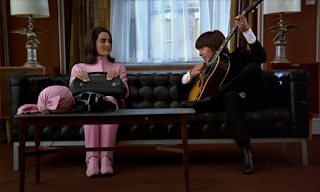Alternate versions of promos made by the Beatles over the years provide the basis for much of the + portion of this collection. The reason that there were sometimes two or three different films or videos for individual songs was due to the fact that each competing broadcasting outlet wanted to feel as if it had an exclusive clip. This was especially true in the UK. Manager Brian Epstein catered to the demands of the powers that be and made sure that multiple versions were produced, some featuring only subtle differences and others using a completely different setup. We start off this part, however, with a clip from a show that helped to inspire much of what would soon follow.
My song by song, album by album look at the work of the Fab Four, from Love Me Do to Let It Be, distilled from multiple sources and accessible to the most casual fans.
Tuesday, May 9, 2023
1+ - part six
Alternate versions of promos made by the Beatles over the years provide the basis for much of the + portion of this collection. The reason that there were sometimes two or three different films or videos for individual songs was due to the fact that each competing broadcasting outlet wanted to feel as if it had an exclusive clip. This was especially true in the UK. Manager Brian Epstein catered to the demands of the powers that be and made sure that multiple versions were produced, some featuring only subtle differences and others using a completely different setup. We start off this part, however, with a clip from a show that helped to inspire much of what would soon follow.
Friday, April 14, 2023
1+ - part five
Sunday, April 2, 2023
1+ - part four
Get Back - The world probably got its first glimpse of the famous rooftop concert with the release of this promotional film, which combines Michael Lindsey-Hogg's footage from all three performances of this song during that historic event. The action does not always match up perfectly with the recording made a few days earlier in the basement studio of the Apple building, but it is glorious nonetheless, including a few shots of the bobbies grouped behind Billy Preston, waiting to shut the whole thing down.
The Ballad of John and Yoko - There's a lot to unpack in this one, which is nicely put together. John and Yoko are seen in the back of his white Rolls-Royce, in black and white footage from their Amsterdam bed-in, and sitting in a bag at a press conference in Vienna. Apple executive Peter Brown is seen on the phone when he is mentioned in the lyrics. All of this is interspersed with a good deal of Michael Lindsey-Hogg's footage of all four Beatles during the early days of the Get Back project at Twickenham Film Studios, giving the impression that this recording is a group effort, even though only John and Paul play on the record. The cleverest bit occurs when a lone devotee of Krishna is seen sitting in a corner at Twickenham on the line "you don't take nothing with you but your soul."
Something - While the four Beatles could not be bothered to get together to shoot a promotional film for George Harrison's only A-side, they did agree to be seen with their wives, which actually makes for a rather nice piece to accompany this great love song. Longtime assistant Neil Aspinall shot George and Pattie in Esher, John and Yoko at Tittenhurst, and Ringo and Maureen near their home. Paul and Linda provided their own footage from Scotland, including some shots of themselves frolicking with sheepdog Martha.
Come Together - This is an animated film that was created for the original release of the album 1 and the launch of the group's website in 2000. The figures of the Beatles are clothed as on the cover of Abbey Road. They are seen floating with umbrellas, riding go carts and sitting in large teacups like those at amusement parks. At times, they are also seen with guitars and Ringo wearing a big marching band bass drum. Near the end of the song, they march across a giant spiraling keyboard resembling the zebra crossing on the famous album cover.
Let it Be - Michael Lindsey-Hogg's footage from January 31st in the Apple basement studio accompanies the single version of McCartney's great hymn. Thus, though we see George playing a guitar solo on film, what we hear is his overdubbed solo from April of 1969. While there are no shots of Billy Preston, we do see Yoko sitting on the floor beside John.
The Long and Winding Road - For this clip of their final American single, we hear the actual sound from January 31st instead of Phil Spector's orchestra and choir. This is, in fact, an entirely different take shot on that day. We thus get some vocal variations from Paul, including alternate words at times. Billy Preston is seen here, playing a nice solo in place of the huge orchestration we are used to hearing. Curiously, the final shot is the exact same one we just saw at the end of Let it Be, showing Glyn Johns and part of the film crew off to the side of the grand piano.












